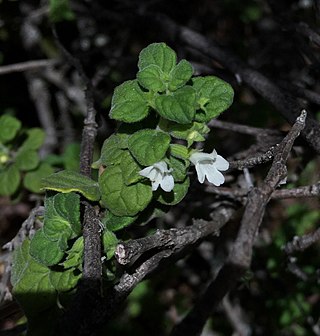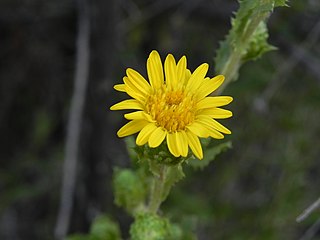
Bergerocactus emoryi is a species of cactus, known commonly as the golden-spined cereus, golden snake cactus, velvet cactus or golden club cactus. It is a relatively small cactus, but it can form dense thickets or colonies, with the dense yellow spines giving off a velvety appearance when backlit by the sun. From April to May, yellow, green-tinged flowers emerge, which transform into reddish, globular fruit. This species is native to the California Floristic Province, and is found in northwestern Baja California and a small part of California, in San Diego County and on the southern Channel Islands. Where the Mediterranean climate of the California Floristic Province collides with the subtropical Sonoran Desert near El Rosario, hybrids with two other species of cacti are found. It is the sole member of the monotypic genus Bergerocactus, named after German botanist Alwin Berger.

Hazardia is a small genus of North American flowering plants in the family Asteraceae. Plants in this genus may be called bristleweeds or goldenbushes.
Hazardia cana is a rare North American species of shrubs in the family Asteraceae known by the common names Guadalupe hazardia, San Clemente Island hazardia, or simply island hazardia. It is native to San Clemente Island, one of the Channel Islands of California, and to Guadalupe Island.

Hazardia squarrosa is a North American species of shrub in the family Asteraceae known by the common name sawtooth goldenbush. It is native to California in the United States and Baja California in Mexico.

Ceanothus verrucosus is a species of shrub in the family Rhamnaceae known by the common names wart-stem ceanothus, barranca brush, coast lilac and white coast ceanothus. It is endemic to northwestern Baja California and San Diego County, where it grows in coastal sage scrub and coastal succulent scrub habitats. It is considered a rare species north of the international border, as most of the valuable coastal land that hosts this plant in the San Diego area has been claimed for development. In California, several extant populations still remain scattered around the region, such as one protected at Torrey Pines.

Salvia munzii is a semi-evergreen perennial species of sage known by the common name Munz's sage or San Miguel Mountain sage. It is native to northern Baja California, Mexico, and it can be found in a few locations just north of the border in San Diego County, California, where it is particularly rare. It is characterized by small leaves and clear blue flowers. It is a member of the coastal sage scrub and chaparral plant communities.

Clinopodium chandleri is an uncommon species of flowering plant in the mint family known by the common name San Miguel savory. It is native to northern Baja California and several areas of southern California, where it can be found in mountain chaparral. A fragrant plant with white flowers, it is one of southern California's rarest shrubs.
Hazardia orcuttii is a rare North American species of flowering plant in the family Asteraceae known by the common names Orcutt's bristleweed and Orcutt's goldenbush. It is native to California in the United States and Baja California in Mexico. It can be found in one location in California, in the city of Encinitas. There, it is located in and near a protected zone known as the Manchester Conservation Area. In Baja California it can be found at 11 to 17 locations.

Dudleya attenuata is a species of perennial succulent plant known by the common name taper-tip liveforever, native to Baja California and a small portion of California. It is a rosette-forming leaf succulent which has narrow pencil-shaped leaves that can often be found covered in a white epicuticular wax. The thin, sprawling stems branch to form the clusters of rosettes, with plants creating a "clump" up to 40 cm wide. The small flowers are white or yellow, with 5 spreading petals. It is a diverse, variable species that extends from the southernmost coast of San Diego County to an area slightly north of the Vizcaino Desert, hybridizing with many other species of Dudleya in its range. Some plants with white or pinkish flowers were referred to as Orcutt's liveforever, referring to a former subspecies split on the basis of the flower color.

Dudleya ingens is a species of perennial succulent plant in the family Crassulaceae commonly known as the rock liveforever or Baja liveforever. A relatively large member of the genus Dudleya, this species has long green succulent leaves, and in April to June is characterized by pale yellow to white pink-tinged flowers topping tall, reddish inflorescences. It has a stem clothed densely with old, leathery leaves, and the inflorescence may be nodding, with the floral branches bearing the flowers tending to unfurl like the fronds of a fern. It is similar in appearance to Dudleya brittonii, but differs in range and chromosome number. This species is endemic to the state of Baja California in Mexico, being found from Santo Tomás to the southern coast of the state.

Ambrosia monogyra is a species of flowering plant in the sunflower family commonly known as the singlewhorl burrobrush, leafy burrobush, slender burrobush, and desert fragrance. Ambrosia monogyra is native to North America and is typically found in canyons, desert washes, and ravines throughout arid parts of the southwestern United States and northern Mexico. This species has green, threadlike leaves that emit a distinctive odor when crushed, and flowers from August to November. The fruits have distinctive wings in their middle that aid in dispersion through wind and water.

Hazardia berberidis is a species of flowering plant in the family Asteraceae commonly known as the barberry-leaf goldenbush. A woody shrub, it is characterized by sawtooth leaves and yellow ray flowers that bloom from March to August. It is endemic to the coastal sage scrub and coastal succulent scrub habitats of Baja California, Mexico, but with populations of uncertain origin in San Diego County, California.
Hazardia ferrisiae is a Mexican species of shrub in the family Asteraceae. It has been found only in the state of Baja California in northwestern Mexico.
Hazardia vernicosa is a Mexican species of shrub in the family Asteraceae. It has been found only in the state of Baja California in northwestern Mexico, specifically near El Rosario. It has not been found in the United States although one of the Mexican populations is less than 10 km south of the international border.

Diplacus puniceus, commonly known as the red bush monkeyflower, San Diego monkey flower, or mission diplacus, is a species of perennial shrub native to coastal southern California and northern Baja California. It is characterized by a relatively small and broad corolla for Diplacus, a lack of glandular hairs, and dark orange or red flowers, adapted to hummingbird pollinators.

Dudleya anomala is a rare species of succulent plant in the family Crassulaceae commonly known as the Todos Santos liveforever. With a dense, cushion-forming habit, this leaf succulent is characterized by elongated stems, slightly sticky leaves, and bell-shaped flowers with white, spreading petals. This species is native to Baja California, Mexico, and is found primarily on islands and one coastal locality.

Dudleya gatesii, known by the common name as Gates'liveforever, is a species of perennial succulent plant in the family Crassulaceae. It is native to the central desert of the Baja California peninsula, found growing along dry and rocky outcroppings. It is characterized by red inflorescences topped with white flowers, bracts that are often reflexed downwards, and a rosette of dark-green leaves turning reddish.

Dudleya cochimiana, commonly known as the Cochimíliveforever, is a species of succulent plant in the family Crassulaceae endemic to Cedros Island, a large island off of the coast of Baja California, Mexico. It is a rosette-forming leaf succulent characterized by broad, green to white leaves, and flowers with white to pink petals. It can be found on rocky slopes and canyons along the island.

Jatropha moranii is a very rare subshrub in the genus Jatropha known commonly as Moran's lomboy. This species in the family Euphorbiaceae is endemic to a small area of Cabo San Lucas in Baja California Sur. It is characterized by a succulent stem and branches, along with a distinct woody caudex, and attractive white flowers.

Lepechinia hastata is a rare species of perennial shrub in the mint family commonly known as the Cape pitcher sage or Baja pitcher sage. Lepechinia hastata is an aromatic shrub characterized by large, arrowhead-shaped leaves and attractive purple to magenta flowers. In the wild, it is known from the forested mountains of the Sierra de la Laguna in Baja California Sur and the volcanic Socorro Island in the Pacific Ocean, both part of Mexico. The plants of Socorro Island are their own subspecies, and differ in their white flowers and wooly, grayer foliage.

















